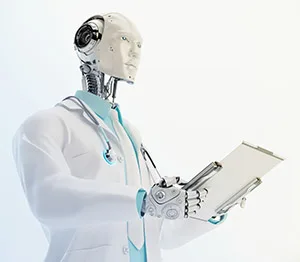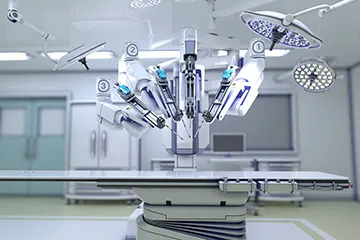Robots in the Medical Field

By Ibby Smith Stofer
How can a hospital or healthcare facility improve sterility and potentially reduce hospital-acquired infections?
What device can aid in delivery of food, supplies to various departments or locations within the healthcare site?
How can a healthcare center achieve greater accuracy in filling prescriptions and simultaneously eliminate potential need to increase staff?
The above questions all have a common answer: Utilize Robotic Technology.
Today medical robots are serving a wide variety of functions in hospitals throughout the world as well as in America.
Medical robotic technology in healthcare comes in many forms and can be segmented as follows: surgical robots, rehabilitation robots, non-invasive radiosurgery robots, hospital and pharmacy robots and others, which serve the neurology, orthopedics, laparoscopy and special education areas.
Robots can sanitize and clean rooms helping to eliminate germs that contribute to hospital acquired infections. In addition, these units aid the housekeeping and central supply staff productivity and often provide savings versus buying additional supplies and or staffing additions. When clinical staff is freed from chasing down equipment and supplies the time they have to spend caring for patients increases dramatically. This is where having robots in the field really pays off.
What if the food service or central supply did not require individuals to hand deliver meals or restock supplies? That again is where medical robots should improve both efficiency and productivity for multiple areas.
What if hospital pharmacists did not have to interpret handwritten orders, retrieve and repackage prescription medicines? Hospital robots can and are doing all this and more to improve productivity in many hospital-based pharmacies.
What if as you walked in the front door as a visitor and you were greeted by a robot who not only inquired as to why you were there but who you were planning to see? In addition, he then either guided you to your destination or gave you detailed but simple instructions to guide you? Would that not be better than scanning a directory or inquiring at the reception area and being left on your own to find room 3C in wing 4?
There are many hospitals who are finding that medical robotic technology can help them provide services, perform surgeries and aid in rehabilitation while simultaneously helping to reduce costs by improving processes, efficiencies and care.
Yes, robots seem to have a definite place in healthcare but they go well beyond the walls of the hospital. There are robots that can assist in the home or physical therapy centers that aid patients in standing or walking. There are robots that can connect via Skype to the primary care physician and even walk up to the patient by remote control. Some can even hold a spoon to assist patients in feeding themselves.

The questions that some raise in opposition of robots is will all these robots in the medical field replace the nurse, physician, or pharmacist. The answer most likely is no. Healthcare is about people taking care of people and robots are tools to help improve productivity, efficiency, and quality of care. Robots are just part of the changing landscape we encounter in our daily lives. UCSF Health system in San Francisco has a fleet of robots that provide a wide variety of functions and the reaction when they were introduced to the press were captured in an article in June 2015 in Healthcare Finance. (http://www.hfmmagazine.com/)
Since robotic technology was introduced with the da Vinci Surgical System in 2007, why has the adoption been slower than in other industries?
Consider the following definition: “In its simplest form, a robot is a device that performs one or more actions in response to one or more stimuli.” and consider the many routine tasks that hospital personnel perform during their shifts. It appears that many of the processes can easily be automated or robotized.
Think about how many devices in your life perform specific actions in response to stimuli. Robots are well integrated into our lives, into all manufacturing and some retail establishments. Healthcare is finding that robots can play an even more significant role in both process improvement and costs reduction. Be on the lookout for them on your next visit.
